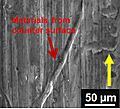Wear (erosion) facts for kids
In materials science, wear is when a material slowly leaves the surface of a solid object. This happens because another solid object rubs against it. Studying wear is part of a field called tribology.
There are four main ways wear happens:
- Adhesive wear
- Abrasive wear
- Corrosive wear
- Surface fatigue
Contents
What is Wear?
Wear means that a material changes or gets damaged over time. It's like when your favorite shoes get worn out from walking. Wear is different from other ways materials break down, like when something bends permanently or cracks suddenly.
Materials usually go through three stages as they wear out:
- First stage: This is the beginning, or "run-in" period. Things might change quickly at first.
- Second stage: This is the longest and most useful part of a material's life. Wear happens at a steady, slow rate.
- Third stage: In this final stage, wear speeds up very quickly. This often leads to the material breaking or failing.
If conditions are harsh, like very hot temperatures or strong forces, the useful second stage can become much shorter. This makes the material wear out and fail much faster. Engineers often use special treatments on surfaces to make them last longer and reduce wear.
Sticky Wear: Adhesive Wear
Adhesive wear happens when two solid surfaces slide over each other while pressing together. It's like when two sticky things touch and then pull apart, leaving bits behind. This type of wear can also be called scoring or galling.
Rubbing Wear: Abrasive Wear
Abrasive wear happens when hard particles rub against a surface and remove material. These particles can be part of another surface, like sandpaper. Or they can be loose bits trapped between two surfaces that are rubbing. Imagine tiny rocks scratching a smooth floor.
Rusty Wear: Corrosive Wear
Corrosive wear is when a material gets damaged because it reacts with its surroundings. A common example is corrosion, like when metal rusts. This reaction makes the material lose its useful properties over time.
Tired Surfaces: Surface Fatigue
Surface fatigue happens when the surface of a material gets weaker from repeated pushing or pulling. It's a type of general material fatigue. Think of bending a paperclip back and forth many times until it breaks. The surface gets "tired" and can start to crack.
Images for kids
See also
 In Spanish: Desgaste para niños
In Spanish: Desgaste para niños




